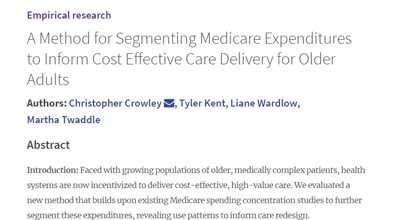
Crowley, C, Kent, T, Wardlow, L and Twaddle, M. 2019 A Method for Segmenting Medicare Expenditures to Inform Cost Effective Care Delivery for Older Adults. eGEMs (Generating Evidence & Methods to improve patient outcomes), 7(1): 28, pp. 1–10. DOI: https://doi.org/10.5334/egems.272
Abstract
Introduction: Faced with growing populations of older, medically complex patients, health systems are now incentivized to deliver cost-effective, high-value care. We evaluated a new method that builds upon existing Medicare spending concentration studies to further segment these expenditures, revealing use patterns to inform care redesign.
Methods: We obtained monthly Medicare expenditure data and derived baseline comparison data using typical methods for identifying a yearly high-cost subpopulation. We then applied the new methodology, ordering monthly patient expenditures from highest to lowest to more extensively segment the baseline data. Our evaluation examined the following within the new more extensive segmentation: monthly expenditure distribution, corresponding patient counts, and occupancy of specific patient subgroups within the extended segmentation of baseline data.
Results: Compared to the baseline data, we found further spending concentration, with 16.7 percent of high-cost patients being responsible for about two-thirds of baseline expenditures. The remaining 83.3 percent of the high-cost subpopulation exhibited lower spending, collectively accounting for about one third of baseline expenditures. Additionally, we found that unique patient subgroups occupied different segments over time, with specific subgroups comprising 8.3 percent of the study subpopulation patients migrating into and out of each highest spending segment, accounting for almost half of monthly baseline expenditures.
Conclusions: With monthly healthcare expenditures concentrated among small numbers of migrating patients, our evaluation suggested potential cost-effectiveness in tiered care delivery models, where small subgroups receive direct, active care interactions, while the remainder experience surveillance-level care, designed to both address ongoing medical needs and to detect emergent migration.
PLEASE READ THE FULL PAPER AT EGEMS.ACADEMYHEALTH.ORG

